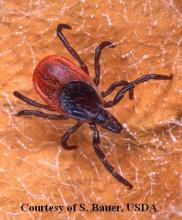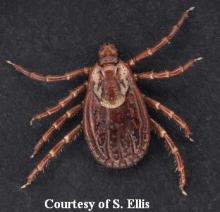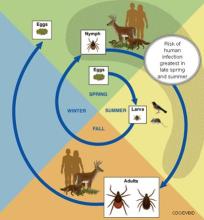Tick Information and Prevention
Protection and Prevention
People who live, work, or play in places near woods or overgrown brush are at risk of tick-borne diseases. You can reduce your risk. When possible, avoid infested areas, especially in the spring. Ticks thrive in moist, shaded environments where deer and rodent hosts are abundant. You should be extra vigilant in warmer months (April-September), when ticks are most active. To prevent bites:
- Wear light-color clothing (makes ticks easier to see)
- Long-sleeved shirts, pants, and boots that come up above the ankles
- Tick pants into boots or socks
- Conduct periodic ‘tick checks’ every few hours during outside play (maybe while reapplying sunscreen or insect repellent).
When you get home, remember to:
- Bathe or shower after coming indoors, preferably within two hours, to wash off or find ticks that are crawling on you. This will also reduce your exposure to other skin irritants such as poison ivy, poison oak, etc.
- Conduct a full-body tick check using a hand-held or full-length mirror to view all parts of your body.
- Parents should check their children under the arms, in and around the ears, inside the belly button, behind the knees, between the legs, around the waist, and hair.
Should you find an attached tick, use the procedure described below. - Examine gear and pets. Tumble clothes in a dryer on high heat for an hour to kill undiscovered ticks.
Insect Repellents
Insect repellents that contain DEET or permethrin are effective ways to prevent tick bites. Sprays that contain 20% or more DEET (N, N-diethyl-m-toluamide) can last up to several hours when applied on the exposed skin for protection. Parents should avoid hands, eyes, and mouth when applying this product to their children.
Permethrin products should be used on clothes (not skin). Treat clothing and gear, such as boots, pants, socks and tents. It remains protective through several washings. Pre-treated clothing is available and remains protective for up to 70 washings. Always follow product instructions. Find other repellents registered by the Environmental Protection Agency (EPA) at http://cfpub.epa.gov/oppref/insect/.
How to Remove Ticks
It is important to remove ticks as soon as they are found. It can take several hours or even days for an attached tick to spread a disease.

Do not remove a tick using nail polish, petroleum jelly, alcohol or a hot match. These can increase your chances of getting a disease from a tick. The best way to remove a tick is:
- Get tweezers (fine-tipped are best), a sealable container or bag, and antiseptic.
- Grasp the tick with your tweezers, as close to the skin as possible.
- Gently, but firmly, pull the tick straight out. Do not twist or jerk the tick.
- Place the tick in the container. If you plan to identify the tick, you can save it in rubbing alcohol.
- Wash your hands with warm, soapy water.
- Apply antiseptic to the bite site.
If a rash appears, contact your doctor.
Ticks In Alexandria
Ticks are arachnids and are close relatives to spiders. They can vary in size. They can be the size of a poppy seed to that of an apple seed. Ticks live in grasses, bushes, and other vegetation. The most common types of ticks in our area are:
Black Legged Tick (Deer Tick)
Ixodes scapularisAmerican Dog Tick
Dermacentor variabilisLone Star Tick
Amblyomma Aamericanum


Ticks can spread diseases through their bites, but not every bite will make you sick. More information about these diseases is below.
Tick Biology
A tick’s lifecycle varies by the tick species and the climate. The typical tick lifecycle is one to two years. There are four stages of growth: egg, larva, nymph and adult.

After hatching from eggs, larvae, nymphs and adults need blood from a host (us) to mature. When a tick feeds, it can transmit a disease to its host. This is most likely to happen from ticks in the nymph and adult stages.
Ticks do not jump or fly onto people or animals. Instead, they use a method called “questing“, which is when a tick waits on low vegetation (tall grass) and attaches itself to a host as he or she passes. Ticks identify hosts through cues such as carbon dioxide as well as heat and movement.
Once a tick attaches to a host, it can feed for several days to several weeks. The host usually does not feel the bite. If a tick has a disease, the disease is not transmitted to the host immediately--it can take several hours (or even days) after biting for the host to get the disease.
Diseases Carried by Ticks
The Center for Disease Control (CDC) lists common symptoms of tick-borne infections. When diagnosed properly, tick-borne diseases can usually be treated with antibiotics.
- Lyme Disease symptoms include fever, headache, fatigue, and sometimes the characteristic bull’s-eye like skin rash (see picture). If left untreated, infection can spread to the joints, heart, and nervous system.

- Rocky Mountain Spotted Fever (RMSF) symptoms include fever, headache, abdominal pain, vomiting, and muscle pain. A rash may also develop, but is often absent in the first few days, and in some patients, never develops. Rocky Mountain spotted fever can be severe or even fatal if not treated within the first few days of symptoms.
- Ehrlichiosis symptoms include fever, headache, fatigue, and muscle aches. Usually, these symptoms occur within one to two weeks following a tick bite.
All tick-borne diseases are preventable if simple steps are taken to reduce exposure to ticks.
Ticks and Pets
Dogs are very susceptible to tick bites and tick-borne diseases. Vaccines for pets are not available for all tick-borne diseases, and they don’t keep pets from bringing ticks into your home.
For these reasons, it’s important to use a tick preventive product on your pet. Tick bites on dogs may be hard to detect. Signs of tick-borne disease may not appear for seven to 21 days or longer after a tick bite, so watch your pet closely for changes in behavior or appetite if you suspect it’s been bitten by a tick.

To reduce the chances that a tick will transmit disease to you or your pets:
- Check your pets for ticks daily, especially after they spend time outdoors.
- If you find a tick on your dog, remove it right away.
- Ask your veterinarian to conduct a tick check at each exam.
- Talk with your veterinarian about tick-borne diseases in your area and about using tick preventives on your pet.
Note: Cats are extremely sensitive to a variety of chemicals. Do not apply any insect repellents to your cats without first consulting your veterinarian!